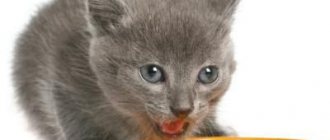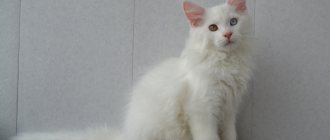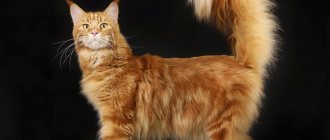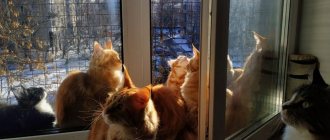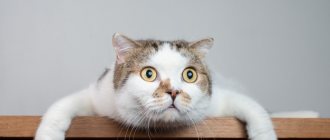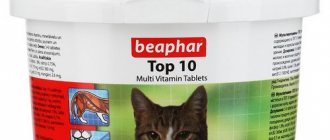7493Administration
Maine Coon cats are beautiful and large representatives of the cat breed. Among them, it is worth highlighting the Maine Coon polydactus, which differs from its relatives in having many toes. Nowadays such special specimens are not found often and arouse the interest of both professional breeders and ordinary people.
Note that polydacts have a wider and heavier bone structure, mainly in the chest and front legs. We will try to figure out what polydactyly is in Maine Coons.
What is polydactyly in a Maine Coon?
Externally, cat polydactyly is manifested only in the structure of the legs. If an ordinary Maine Coon (or any other cat) normally has 18 toes - 5 on the front legs and 4 on the hind legs, then a polydact can grow 24 processes.
This phenomenon is caused by a genetic mutation that does not affect general health and does not pose any threat to the population. The only negative point is the dominance of the gene over all others. If a polydact appears in a group of cats, then very soon all the offspring will be multi-toed.
At one time, this defect was even fashionable, and breeders deliberately kept polydactyl Maine Coons to satisfy the demand for unusual kittens. But later, through the efforts of international associations and expert felinologists, polydactic cats were taken beyond the scope of championship titles and awards, and their deliberate breeding became a rarity.
Cat "in mittens"
Often in the literature you can see that cats with the polydactyly gene are called “mitten” cats. You can get such a kitten by crossing a regular cat and a cat with extra fingers. The autosomal dominant polydactyly gene will be passed on to offspring with a 50% probability . If you hope that the “mitten” will be inherited from ancestors who were once present in your family, you will be disappointed. Only direct inheritance from the carrier of the gene works here.
In one litter, at least one of the polydacts can produce a Maine Coon or regular polydact kitten. Moreover, neither the shape of the paw nor the number of toes are inherited.
The scheme can be briefly described as follows:
1. Parents with polydactylism, both or one - kittens can be:
- with extra fingers
- ordinary
2. A cat from a polydact with the usual number of fingers will never give birth to multi-fingered offspring.
The history of mutations in Maine Coon cats
Legends attribute the six-toed Maine Coons with better hunting qualities, unlike ordinary cats. It was also believed that they brought good luck and shipwrecks avoided those trading ships on which polydactic cats lived. Therefore, the population of Maine Coons with extra shoots on their paws is most widespread in port cities. Superstitious sailors willingly took such animals on long, risky voyages.
Now polydactyl cats are most often found along the Atlantic coast of the USA and Canada, and on the other side of the ocean - in the county of Wales of the British kingdom, less often in Spain, France and Portugal.
The Maine Coon is not the only representative of polydacts in the New World. In America, a short-haired multi-toed cat was officially registered, which appeared almost simultaneously with the large Manx cats.
According to another hypothesis, farmers also found positive qualities in this variety of Maine Coons. Polydactic cats hunted better and were larger and more powerful than their regular counterparts.
The truth, as usual, is located somewhere in the middle. It is a proven fact that polydactic cats do not suffer from their congenital defect and always produce viable offspring. It only takes one polydact for this trait to begin to be passed on from generation to generation and, as a result, quickly cover the entire local Maine Coon population.
The history of the appearance of such deviations
The cause of polydactyly is the inheritance of a mutation gene, but there are several theories about why such a mutation occurred.
One of the most logical is the need to catch animals and move deftly through snow and trees, which is much easier to do with extra fingers.
There is also a belief that Maine Coon polydacts were often used on ship voyages and were a kind of talisman, and their hunting abilities helped fight rats.
In addition, on such paws it was more convenient for them to move around the ship during rocking.
Perhaps it was thanks to such abilities that British cats of this breed were able to enter and reproduce in the territory of modern America.
While ship captains did everything possible to have a Polydactus Maine Coon, the medieval Inquisition mercilessly exterminated them. At that time, any deviation from the norm was considered something demonic, and the increased number of fingers on a cat, which was already considered a guide to the other world, even more so.
Therefore, not many cats with polydacty have survived to this day, and now many nurseries are breeding them.
Do you want a Polydact Maine Coon?
Types of polydactyly in Maine Coons
Pet lovers call polydactyl cats multi-toed cats. This mutation manifests itself in two ways:
- Preaxial, when the process grows to the 4th finger (most often the extra thumb).
- Postaxial, when the process appears behind the 4th finger.
With the development of science and the beginning of serious research, scientists have found that the polydactyl nature of cats does not threaten the health of the general population. Apart from the unusual appearance, it does not cause any other changes in the body of polydactic Maine Coons.
Sometimes there is uneven growth of claws, dysbiosis and infections, but they are typical for any representatives of this breed.
Experts disagree about the physical characteristics of the two groups (normal and genetically altered). Some believe that polydactic cats have better health, but they have not been recorded as being long-lived.
Types of polydacty
There are two types:
- Preaxial – extra thumb
- Postaximal – extra little finger
When crossing a multi-toed cat and a regular cat, a polydact may result.
The presence of an extra thumb is more common than the appearance of an extra little finger. The paw of such a cat resembles a human hand. Sometimes they are called a cat in mittens.
The arrangement of the fingers is not passed on from parents.
Status of Maine Coons with polydactic features
Rehabilitation of cats with 6 fingers began at the beginning of the 21st century. In 2008, felinologists again addressed this issue and decided to return the exhibition status of the Maine Coon variety with polydactyl changes.
This happened on the initiative of American breeders for obvious reasons - the country is still experiencing a steady birth of six-toed kittens, which have to be removed from the stud books. Animal rights activists and green movement activists joined the process. With their support, the matter moved forward.
So far, only 4 international associations allow polydactics to participate in exhibitions - CFA, CFF, ACFA and TICA. All of them are registered in the USA and have long lobbied for the return of Maine Coons with six fingers to the group of show cats.
True, giant cats with altered genetics are not given championship titles, but this issue will be resolved over time.
Crocodile Lolong
He received his nickname in honor of a local high-ranking official who took personal part in the hunt for this man-eating crocodile.
Residents of all surrounding settlements took part in the hunt. After all, it was assumed that the monster, being free, devoured the hunter and the 12-year-old girl. Now the animal, which is officially registered in the Guinness Book of Records as the largest existing crocodiles (its “height” is 6.5 m), lives peacefully in captivity, quite happy with its fate.
Permission to breed
While experts argue, practical breeders have again acquired polydactyl Maine Coons, kittens are born with enviable regularity and the fashion for them is increasing. Unlike the previous wave of demand, now the situation has changed - six-toed big cats have increased in price.
If they are given back the right to climb to the highest steps of the world's pedestals, interest in polydacts will only intensify.
Another difference of modern breeding is its rapid spread on all continents. More recently, these cats could be popular in one territory and completely absent in another.
Now the situation has changed dramatically. Exhibition committees returned the right of six-fingered animals to official existence. This means that the Maine Coon-Polydact will quickly appear in the USA, Europe, and Russia.
Breeding wide-footed cats
Broad-footed Maine Coon breeds are bred in nurseries based on breeding programs, where the corresponding gene is passed on between generations. To produce offspring with polydactyly, one parent must have a foot anomaly - then the birth of offspring with polydactyly is possible with a probability of 56% (not all kittens in the litter are polydactylic).
If you breed two wide-legged animals, the likelihood of having polydact kittens increases by another 20%. Mating, where one parent is a homozygous polydact, leads to the fact that the entire litter will be polydactyl.
Polydactyly in cats
The polydactyly gene behaves unpredictably. It is expressed differently in offspring, regardless of the combination of fingers of the parents. In contrast to other dominant genes, it manifests itself in different ways in both homo- and heterozygous forms.
Breeders of broad-toed cats continue to conduct statistical work, trying to discover more accurate information about the likelihood of producing multi-toed kitten offspring.
Differences between Maine Coon polydacts
There are two branches of the Maine Coon breed - European and American. Another authoritative expert in the field of expertise is FIFe, an international cat federation registered in the UK. This is the oldest felinological center in the world.
But there are still no definite rules regarding how many toes a Maine Coon should have on its paws and in what order they can be located.
It can be expected that breed standards will be revised in the future. But now breeders are completely free from any restrictions on the quality of polydact offspring.
Origin
Having large limbs, cats easily move on slippery surfaces, which is why sailors took them to catch mice on ships.
There are suggestions that Maine raccoon cats were crossed with cats from the ports of Boston, where sailors from their native states often landed. Here, polydactyly in animals was common. Thus, the six-fingered dominant gene entered the breed and became established. Extensive limbs helped cats move easily on slippery surfaces and hunt rodents. Due to the fact that the habitat was closed, polydactyly in Maine Coons spread over many years. Six-toed animals look harmonious, with a strong bone skeleton. Breeders focus on strong joints and ligaments, which makes it possible to move like ordinary cats. Sailors took Maine Coons onto decks to catch rats and mice.
The unusual appearance attracts people's attention and gives rise to mythical stories. Thus, there is an opinion that a cat with extra fingers can bring happiness and good luck, and this is important for traveling on ships. Such animals were bred in Great Britain, Maine, and then in other countries. The island where Hemingway lived was amazing; there were many cats with an unusual number of phalanges on their paws. You can hear the name “Hemingway cats”; they are named after the writer. He opened a museum that displays several dozen exhibits of cats with the mutation.
Advantages and disadvantages of buying such a cat
There are still differences between America and Europe on the issue of advantages. They are associated with mental customs that animal lovers have not stepped over. For the United States, polydactyl Maine Coons are an object of national memory.
Americans do not take into account the causes and consequences of the natural six-toed mutation and believe that the breed has returned to its historical state.
In Europe, polydactics have not been favored since the times of the medieval Inquisition, when all cats with severe defects were mercilessly exterminated. Therefore, residents of the Old World consider the polydactyl cat only as a unique natural phenomenon.
The character of polydactyl Maine Coons is the same as that of ordinary representatives of this breed. All of them are equally friendly towards people, highlight the owner and follow him literally on his heels, love to play and swim, are well trained and are unpretentious to food.
Disadvantages and dangers of polydactyly
In some cases, polydactyly is caused by a gene that leads to the development of other pathologies in the animal. These are deformations of the limbs, improper development of bones, joint diseases, and ingrown claws. Then the animal requires qualified treatment.
One of the dangerous anomalies is the appearance of a three-phalanx thumb. Cats with this pathology often give birth to underdeveloped offspring. Their kittens may have deformed forearms, and therefore such animals are usually sterilized.
Famous fans of polydacts and Maine Coons
Among the adherents of multi-toed Maine Coons was the 26th President of the United States, Theodore Roosevelt. It was under him that Polydact Slippers first appeared at the residence of the head of the American state.
Ernest Hemingway became a fan of Maine Coon polydacts from the moment he was given an unusual six-toed kitten named Snowball.
The legendary Brigitte Bordos willingly posed for photo reporters with her huge Maine Coon. After finishing her film career, the actress devoted her life to protecting animals and the environment.
Elena Mikhalkova (author of action-packed novels) periodically delights her audience with short literary essays in which she describes the life and habits of a ten-kilogram Maine Coon.
We can say that after felinologists recognized the Maine Coons as polydacts, historical justice triumphed and the breed acquired its original appearance.
Expert proposals have already been made to separate polydactyl cats into a separate group, but it is unlikely that fanciers will purchase and keep only six-toed animals. Maine Coons are prized for their enormous size and affectionate nature. And it doesn’t matter how many toes a cat has.
Nature and features of the anomaly
Polydactyly, or polydactyly , is an anatomical anomaly that consists of the presence of extra fingers.
Polydactyly is transmitted genetically
It is customary to distinguish the following forms of manifestation of polydactyly:
- preaxial – another thumb (typical of multi-toed cats);
- postaxial – extra little finger (more common in people with polydactyly).
A polydactyl cat does not have problems with the musculoskeletal system; this does not prevent the kitten from leading a full life.
The extra finger is only noticeable visually - the kitten's paws resemble mittens - but this does not interfere with the normal development of the baby.
America's National Treasure
Several years ago, a threat loomed over the inhabitants of Ernest Hemingway's house-museum. According to the law of the state of Florida, which includes the island of Key West, each citizen can keep no more than four cats in his home.
The Department of Agriculture filed a lawsuit against the museum administration. The statement claimed that keeping so many cats was illegal, as was showing them to visitors for money. The litigation lasted for several years, but the museum staff defended their pets. Now the cats living on the territory of Ernest Hemingway's house are considered a national treasure of America and are officially protected by law.
